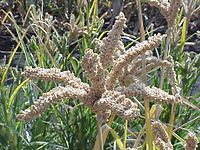
Photo from wikipedia
Iron deficiency and anemia are common in low- and middle-income countries. This is due to a poor dietary iron density and low iron absorption resulting from the high inhibitory phytic… Click to show full abstract
Iron deficiency and anemia are common in low- and middle-income countries. This is due to a poor dietary iron density and low iron absorption resulting from the high inhibitory phytic acid content in cereal and millet-based diets. Here, we report that a naturally occurring low phytic acid finger millet accession (571 mg 100 g−1), stable across three growing seasons with normal iron content (3.6 mg 100 g−1), increases iron absorption by 3-folds in normal Indian women. The accessions differing in grain phytic acid content, GE 2358 (low), and GE1004 (high) were selected from a core collection of 623 accessions. Whole genome re-sequencing of the accessions revealed significant single nucleotide variations segregating them into distinct clades. A non-synonymous mutation in the EcABCC phytic acid transporter gene between high and low accessions could affect gene function and result in phytic acid differences. The highly sensitive dual stable-isotope erythrocyte incorporation method was adopted to assess the fractional iron absorption. The low phytic acid accession resulted in a significantly higher iron absorption compared with the high phytic acid accession (3.7 vs. 1.3%, p < 0.05). The low phytic acid accession could be effective in preventing iron deficiency in regions where finger millet is habitually eaten. With its low water requirement, finger millet leaves low environmental footprints and hence would be an excellent sustainable strategy to mitigate iron deficiency.
Journal Title: Frontiers in Nutrition
Year Published: 2022
Link to full text (if available)
Share on Social Media: Sign Up to like & get
recommendations!